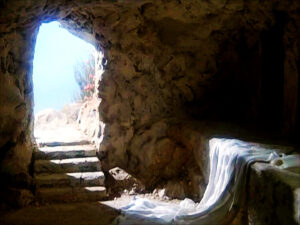 On 31 March 2013 Western Christians (Protestants and Roman Catholics) will be celebrating Jesus Christ’s rising from the dead.
On 31 March 2013 Western Christians (Protestants and Roman Catholics) will be celebrating Jesus Christ’s rising from the dead.
Due to different calendars Western and Eastern Easter celebrations in 2013 will be a month apart: 31 March and 5 May.
Many have wondered: Why the difference in Easter dates?
The First Ecumenical Council (Nicea 325) instructed that the celebration of Easter (Pascha) should fall on the Sunday following the first vernal full moon (Synodal Letter; Eusebius’ Vita Constantine Book III Chapter V-XVIII). However, even with these instructions there would still be differences over how to carry out these instructions.
Fact Monster has an interesting article: “A Tale of Two Easters: Why one faith and two celebrations?” by Borgna Brunner that gives an overview of a complex and knotty problem:
The Western church does not use the actual, or astronomically correct date for the vernal equinox, but a fixed date (March 21). And by full moon it does not mean the astronomical full moon but the “ecclesiastical moon,” which is based on tables created by the church. These constructs allow the date of Easter to be calculated in advance rather than determined by actual astronomical observances, which are naturally less predictable.
Eastern Christianity uses a different approach to setting the Easter date:
The Eastern Church sets the date of Easter according to the actual, astronomical full moon and the actual equinox as observed along the meridian of Jerusalem, site of the Crucifixion and Resurrection.
There have been attempts to set a common Easter date for all Christians, e.g., by the World Council of Churches at Aleppo in 1997. However, for Orthodox Christians resolution of the issue can only come through an Ecumenical Council that stands in continuity with the previous Seven Ecumenical Councils. A common Easter date would do little to heal the differences over more significant issues like the Filioque and the Pentarchy.
Differences over dates and fasting practices should not be grounds for excommunication. In the second century a controversy broke out over when Easter was to be celebrated. Some celebrated Easter on Sunday, while others celebrated Easter in the middle of the week if the 14th of lunar month of Nisan (the Jewish dating for Passover) occurred in the middle of the week. The churches of Asia Minor appealed to its following an ancient practice, but Pope Victor of Rome excommunicated them (c. 189-199) for not being in conformity with the other churches. Irenaeus of Lyons intervened by: (1) condemning the Quartodeciman practice and (2) reproaching Pope Victor for not keeping to moderation of his predecessors. For more on the Quartodeciman controversy see: Eusebius Church History 5.24 and the Catholic Encyclopedia article “Easter Controversy.”
The lesson to be learned here is the need to give importance to the major issues over the minor ones. Christ’s resurrection lies at the heart of the Good News. Western Christians, if they hold to the historical reality of Christ’s death and his third day resurrection, they have much in common with Orthodox Christians.
Robert Arakaki
See also About.com “Why Does the Date for Easter Change Every Year?”
With joy — and respect to my Orthodox brothers — I proclaim ” The Lord is Risen!”
(what’s a month between friends in our God?)
after all: yesterday, today and forever.
Peace be with us all.+
I don’t think this is correct. However you define “the actual equinox as observed along the meridian of Jerusalem” (i.e. as either referring to the date when the day and night are equal lengths, which occurred around March 16th) or as the astronomical equinox (which occurred on March 20th), the first full moon after the equinox was on March 27th, which would make Pascha tomorrow.
According to Wikipedia
This gets us a lot closer, since the Julian and Gregorian calenders are currently off by 13 days, March 21st in the Julian calender would be April 3, but it still doesn’t line up with Nicaea since May 5th isn’t the first Sunday after any full moon let alone the first vernal full moon (it’s the second Sunday after April’s full moon), unless the Eastern churches also define “full moon” as an “ecclesiastical moon.”
I just have accept it for what it is, as I tend to get too concerned about figuring things out to make sure they follow the rules.
Ooops my first quote above is incorrect, I was responding to the following quote:
Benjamin,
I appreciate your comments. I agree with your closing sentence which I will reiterate in bold:
Robert
Then what is the point of posting the rationale?
Laura,
My intention was to facilitate better understanding between Western and Eastern Christians. Lack of understanding about the circumstances that underlay different practices can often hinder communication among the different religious traditions. Think of it as clearing the underbrush so the real work of reconciliation can be done.
Robert
Benjamin’s suspicions are correct; FactMonster is wrong. The Eastern Orthodox do NOT use “the actual, astronomical full moon and the actual equinox as observed along the meridian of Jerusalem.” A proposal to do this was accepted by an Orthodox synod in 1923, but the proposal was never permanently put into effect. The Eastern church, like the Western, uses an approximate, ecclesiastical moon. The Western Paschal Full moon this year was March 27th. The Eastern Paschal Full Moon (νομικον φασκα) is on April 30th. The reason why the Eastern church says the moon is full five days after our eyes see a full moon is that the Eastern tables have drifted from the astronomical facts over the centuries without ever being corrected.
Mockingbird,
Thank you for your input! I must admit the situation is a lot messier and complicated than I would have guessed.
Robert